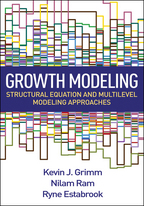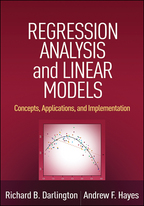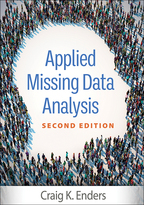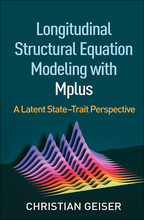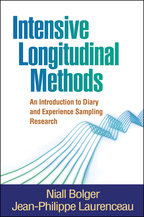Growth Modeling
Structural Equation and Multilevel Modeling Approaches
Kevin J. Grimm, Nilam Ram, and Ryne Estabrook
Hardcovere-bookprint + e-book
Hardcover
orderOctober 17, 2016
ISBN 9781462526062
Price: $92.00 537 Pages
Size: 7" x 10"
Read the Series Editor's Note by Todd D. Little
“An accessible resource that provides a thorough introduction to frequently used longitudinal models….An invaluable resource for students and scholars….This book would be excellent reading material for students in various disciplines, such as psychology and education, that provide either introductory or advanced longitudinal graduate courses.”

—Psychometrika
“This is by far the most comprehensive, up-to-date, and ready-to-use book on growth modeling that I have ever seen. The authors have proven records in effectively teaching classes and workshops on longitudinal data analysis. This is a 'must have' for anyone who wants to develop or apply growth models. The SAS, Mplus, and OpenMx example scripts and instructions are long-needed complements to those programs' respective manuals. Coverage includes the most recent developments in growth modeling, and each chapter essentially can stand by itself, providing enough information for researchers to apply the respective models in their studies to answer more complex and interesting empirical questions. The book can be used in a range of classes either as a main text or a supplement. I will definitely recommend it to students in my Structural Equation Modeling class when I teach structural growth curve modeling.”

—Zhiyong Johnny Zhang, PhD, Department of Psychology, University of Notre Dame
“The implementation details are superb and the level of technical detail quite stunning. It will be so helpful for longitudinal researchers to have this compendium of growth models, complete with sample code from both SEM and multilevel modeling frameworks. It is wonderful to see the item response theory and SEM frameworks so nicely integrated. The authors have hit the trifecta—pulling together multilevel modeling, SEM, and item response theory. There is truly no other book on the market that covers latent growth modeling so completely and comprehensively.”

—D. Betsy McCoach, PhD, Measurement, Evaluation, and Assessment Program, Neag School of Education, University of Connecticut
“This is the most thorough work on this subject that I know of; the coverage of nonlinear models is among the best I have seen. The book is written at a level suitable for an advanced graduate student learning this material or an applied researcher seeking a reference on the subject. It introduces the basics, discusses the relevant model theory/specification, and presents programming code for several packages. The authors do an exceptional job of explaining the computer code and providing insight into convergence issues and how to remedy them. It is good to have this all in one place (along with the respective output) for comparative purposes.”

—Daniel A. Powers, PhD, Department of Sociology, University of Texas at Austin
“This well-written book starts with clear statements about what research questions can be answered using growth models. Usefully, the authors include both multilevel modeling and SEM approaches, and analyze the example data within each framework using one proprietary program and one freely available R package. Viewing the detailed code and the results of each analysis gives the reader a chance to understand the strengths and weaknesses of each approach. Later chapters address such developments as nonlinear growth models and growth models for noncontinuous outcomes. Code for each variation is given, which expand the researcher's capacity to fit these complex models.”

—Yasuo Miyazaki, PhD, Associate Professor of Educational Research and Evaluation Program, Virginia Tech
“The importance that researchers and practitioners are placing on longitudinal designs and analyses signals a prominent shift toward methods that enable a better understanding of the developmental processes thought to underlie many human traits and behaviors. This book provides the essential background on latent growth models and covers several interesting methodological extensions, including models for nonlinear change, growth mixture models, and longitudinal models for assessing change in latent variables. Practical examples are woven throughout the text, accompanied by extensive annotated code in SAS, Mplus, and R, which makes both basic and more complex models accessible. This is a wonderful resource for anyone serious about longitudinal data analysis.”

—Jeffrey R. Harring, PhD, Department of Human Development and Quantitative Methodology, University of Maryland
“I highly recommend this book. It is a tour de force in model building with latent growth curves. The authors' use of three programming languages (Mplus, SAS, and R) is great, and they work with computer programs in an unusually careful way. The book will be of value to anyone dealing with longitudinal data.”

—John J. McArdle, PhD, Department of Psychology, University of Southern California
—Psychometrika
“This is by far the most comprehensive, up-to-date, and ready-to-use book on growth modeling that I have ever seen. The authors have proven records in effectively teaching classes and workshops on longitudinal data analysis. This is a 'must have' for anyone who wants to develop or apply growth models. The SAS, Mplus, and OpenMx example scripts and instructions are long-needed complements to those programs' respective manuals. Coverage includes the most recent developments in growth modeling, and each chapter essentially can stand by itself, providing enough information for researchers to apply the respective models in their studies to answer more complex and interesting empirical questions. The book can be used in a range of classes either as a main text or a supplement. I will definitely recommend it to students in my Structural Equation Modeling class when I teach structural growth curve modeling.”
—Zhiyong Johnny Zhang, PhD, Department of Psychology, University of Notre Dame
“The implementation details are superb and the level of technical detail quite stunning. It will be so helpful for longitudinal researchers to have this compendium of growth models, complete with sample code from both SEM and multilevel modeling frameworks. It is wonderful to see the item response theory and SEM frameworks so nicely integrated. The authors have hit the trifecta—pulling together multilevel modeling, SEM, and item response theory. There is truly no other book on the market that covers latent growth modeling so completely and comprehensively.”
—D. Betsy McCoach, PhD, Measurement, Evaluation, and Assessment Program, Neag School of Education, University of Connecticut
“This is the most thorough work on this subject that I know of; the coverage of nonlinear models is among the best I have seen. The book is written at a level suitable for an advanced graduate student learning this material or an applied researcher seeking a reference on the subject. It introduces the basics, discusses the relevant model theory/specification, and presents programming code for several packages. The authors do an exceptional job of explaining the computer code and providing insight into convergence issues and how to remedy them. It is good to have this all in one place (along with the respective output) for comparative purposes.”
—Daniel A. Powers, PhD, Department of Sociology, University of Texas at Austin
“This well-written book starts with clear statements about what research questions can be answered using growth models. Usefully, the authors include both multilevel modeling and SEM approaches, and analyze the example data within each framework using one proprietary program and one freely available R package. Viewing the detailed code and the results of each analysis gives the reader a chance to understand the strengths and weaknesses of each approach. Later chapters address such developments as nonlinear growth models and growth models for noncontinuous outcomes. Code for each variation is given, which expand the researcher's capacity to fit these complex models.”
—Yasuo Miyazaki, PhD, Associate Professor of Educational Research and Evaluation Program, Virginia Tech
“The importance that researchers and practitioners are placing on longitudinal designs and analyses signals a prominent shift toward methods that enable a better understanding of the developmental processes thought to underlie many human traits and behaviors. This book provides the essential background on latent growth models and covers several interesting methodological extensions, including models for nonlinear change, growth mixture models, and longitudinal models for assessing change in latent variables. Practical examples are woven throughout the text, accompanied by extensive annotated code in SAS, Mplus, and R, which makes both basic and more complex models accessible. This is a wonderful resource for anyone serious about longitudinal data analysis.”
—Jeffrey R. Harring, PhD, Department of Human Development and Quantitative Methodology, University of Maryland
“I highly recommend this book. It is a tour de force in model building with latent growth curves. The authors' use of three programming languages (Mplus, SAS, and R) is great, and they work with computer programs in an unusually careful way. The book will be of value to anyone dealing with longitudinal data.”
—John J. McArdle, PhD, Department of Psychology, University of Southern California

